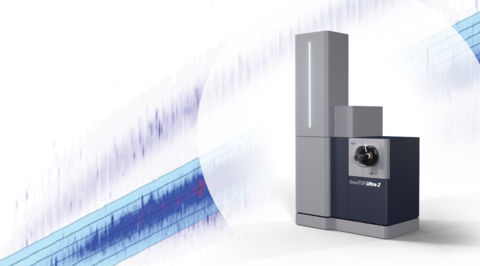Bruker Announces One-Hundred Dollar, Deep, High-Accuracy Plasma Proteome; Advances Glycoproteomics and Metaproteomics
- Robust, Unbiased and Affordable 4D-Proteomics™ for Highest-Specificity Protein IDs & Quant Enables High-Fidelity Large-Scale Plasma Proteomics
- Typical Sequence Coverage >10 Peptides/protein and >100k Peptides per Cell-Line Proteome Ushers in HiFi Proteomics with High Isoform Specificity
- Novel diagonal-PASEF® methods for immunopeptidomics and PTM characterization
-
Achieving
one-hundred-dollar high-fidelity plasma proteomics with PreOmics ENRICH™ and robust timsTOF HT acquisition for deep, unbiased plasma proteomics at scale with99% specificity (1% FDR)
In parallel, Biognosys introduces discovery services with P2 enrichment and Spectronaut® 19 for ultra-deep plasma proteomics with 7k or 9k identified proteins; optional integration of Alamar Bio ultra-high sensitivity NULISA® inflammation and CNS multiplex panels - Glyco-PASEF® acquisition, ENRICHplus and GlycoScape enable high-sensitivity plasma glycopeptide analysis on timsTOF Ultra 2
-
ML-enhanced TIMSrescore™ increases immunopeptidomics and PTM IDs; enables ultra-high-fidelity metaproteomics at
0.1% FDR (99.9% specificity) - Advancing 4D-Multiomics by combining proteomic, lipidomic and metabolomic insights
DRESDEN,

Bruker's timsTOF Ultra 2 Mass Spectrometer (Graphic: Business Wire)
A. Enhanced specificity and proteome coverage using diagonal-PASEF
Leveraging scanning quadrupole and trapped ion mobility spectrometry (TIMS), diagonal-PASEF was introduced in 2023 by key collaborators Dr. Matthias Mann (Max Planck Institute, Martinsried) and Dr. Stefan Tenzer (University of Mainz) to develop synchro-PASEF and midia-PASEF, respectively. Bruker and its partners now support all variants via Spectronaut 19, DIA-NN 1.9, MaxQuant 2.6.3, and midiaID.
Synchro-PASEF allows high-throughput acquisitions, while ensuring quantitative precision due to better sampling of ions, short cycle times, and up to 3-fold improved signal strength.
midia-PASEF offers higher-confidence immunopeptidomics and PTMs by extracting DDA-like spectra for de novo sequencing, and searches against very large databases.
Dr. Jarrod Marto, professor at Dana-Farber Cancer Institute, Harvard Medical School, participated in the midia-PASEF early-access program, and commented: “My lab leverages the timsTOF to understand how genomic alterations or small molecule probes manifest throughout the functional proteome. Our assessment is very positive, and we are now exploring the potential of midia-PASEF for quantitative analysis of post-translational modifications, as well as of MHC-associated peptides.”
B. Achievement of
Bruker spearheads deep, unbiased plasma proteome profiling with throughput, high peptide fidelity, and at enabling economics for large-scale studies. Together, PreOmics ENRICH-iST or ENRICHplus methods, robust and accurate (
Biopharma can access ultra-deep plasma proteome discovery with depth up to 7k proteins, or up to 9k at lower throughput, via research services offered by Biognosys, or by licensing proprietary P2 ultra-deep plasma enrichment for in-house use [Biognosys].
C. Introducing High-Sensitivity Plasma Glycopeptide Analysis on timsTOF Ultra 2
Bruker’s glyco-PASEF® for glycoproteomics has been optimized for the ultra-high sensitivity timsTOF Ultra 2 and human plasma samples. The new method incorporates ENRICHplus, resulting in a doubling of glycopeptides identified, and GlycoScape® data-base-independent software for integrated, deep glycobiology analysis.
D. Increased Peptide and Protein Identifications and ML-enhanced TIMSrescore
The timsTOF platform now routinely identifies much more than 100,000 peptides from human cell line proteomics with less than 1 µg loading in 20 minutes. High sequence coverage of typically >10 peptides/protein is critical for confident ID and quant, high isomer specificity, for detecting PTMs, as well as for immunopeptidomics and metaproteomics.
Bruker also is introducing TIMSrescore, developed with Dr. Lennart Martens’ team at the University of Ghent. Using ML for timsTOF collision cross-sections, retention time and fragment intensity, TIMSrescore increases high-confidence peptide IDs for dda-PASEF, relevant for PTMs and metaproteomics, where highest stringency (
Dr. Lennart Martens, Associate Director of Bioinformatics at the University of Ghent Center for Medical Biotechnology, stated: "My team and I are pleased with the enthusiastic uptake of TIMS2Rescore by our proteomics community. Through integration within Bruker ProteoScape software, we expand MS2rescore to timsTOF users, allowing our ML-based informatics to maximize the value of 4D-Proteomics.”
E. Introducing Multiomics Visualization and Insights for Proteomics and Metabolomics
Bruker ProteoScape™ now offers visualization and statistical analysis of 4D-Multiomics data from MetaboScape® for metabolomics and lipidomics. This enables dimensional reduction (such as PCA, LDA or t-SNE) and differential analysis, as well as intuitive visualizations, e.g., via interactive multiomics Volcano plots.
Dr. Roman Fischer, Associate Professor at University of Oxford, commented: “We utilize our timsTOFs for proteomics and lipidomics. The capabilities of ProteoScape and MetaboScape are impressive for real-time analysis to translate data into biological insights. It’s fantastic that Bruker now integrates both worlds with interactive multiomics visualization and statistical analysis.”
About Bruker Corporation – Leader of the Post-Genomic Era (Nasdaq: BRKR)
Bruker is enabling scientists and engineers to make breakthrough post-genomic discoveries and develop new applications that improve the quality of human life. Bruker’s high performance scientific instruments and high value analytical and diagnostic solutions enable scientists to explore life and materials at molecular, cellular, and microscopic levels. In close cooperation with our customers, Bruker is enabling innovation, improved productivity, and customer success in post-genomic life science molecular and cell biology research, in applied and biopharma applications, in microscopy and nanoanalysis, as well as in industrial and cleantech research, and next-gen semiconductor metrology in support of AI. Bruker offers differentiated, high-value life science and diagnostics systems and solutions in preclinical imaging, clinical phenomics research, proteomics and multiomics, spatial and single-cell biology, functional structural and condensate biology, as well as in clinical microbiology and molecular diagnostics. For more information, please visit www.bruker.com.
View source version on businesswire.com: https://www.businesswire.com/news/home/20241021537973/en/
Media
Petra Scheffer
Bruker Daltonics Marketing Communications
T: +49 (421) 2205-2843
E: petra.scheffer@bruker.com
Investor Relations
Joe Kostka
Associate Director, Investor Relations
T: +1 (978) 313-5800
E: Investor.Relations@bruker.com
Source: Bruker Corporation






